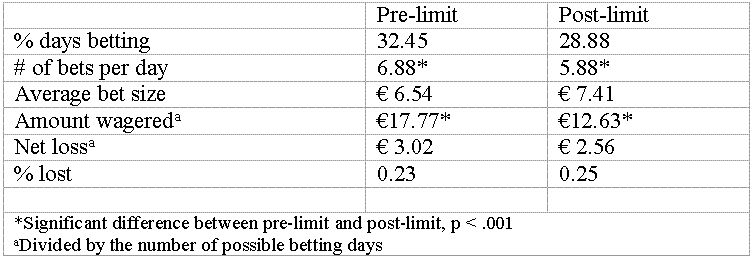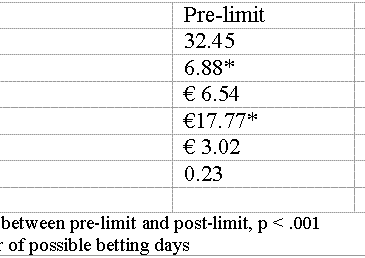Self-limit programs (i.e., programs offered by casinos or Internet gambling sites that impose wagering or deposit limits) are intended to reduce gambling-related harms. This week the WAGER examines the Internet sports gambling behavior of people using the self-limit program of a prominent Internet gambling site (Nelson, LaPlante, Peller, Schumann, LaBrie, & Shaffer, 2008).
Methods
- 567 Internet gamblers who elected to self-limit their gambling deposits (SLs) compared to 46,567 other subscribers to the same betting site (non-SLs)
- Measures of actual Internet sports gambling during an 18 month period: % of days on which a bet was placed; # of bets per day; average bet size; amount wagered; net gambling loss; and % lost (i.e., net loss/amount wagered).
Results
- SLs bet on more days, placed more bets per day, and were more likely to play online games in addition to sports betting than non-SLs.
- After setting self-limits, 10.6% of SLs ceased all betting.
- SLs who continued to bet after setting limits significantly reduced bets per day and total wagered (see Figure 1).
Table 1. Gambling behaviors of self-limiters before and after imposing limits
Adapted from Nelson et al. (in press).
Limitations
- Participants might have gambled on other sites.
- The impact of self-limiting on sports betting might not generalize to other online betting activities, such as poker or casino games.
Conclusion
This study provides preliminary evidence that self-limiting programs are a promising option for Internet gamblers interested in controlling their gambling and also calls attention to the importance of involvement with gambling activity (i.e., days spent betting and bets per day), not just money at risk in distinguishing people with potential gambling problems.
What do you think? Comments can be addressed to Ryan J. Martin.





Randy R. (a recovering problem gambler) April 28, 2016
Usually I just bite my tongue when I read articles from the BASIS – WAGER, but this article makes a leap of faith in the wrong direction, in my opinion. Problem gambling is NOT about money. Those who sign up for “self-limiting” programs are already in serious trouble and this activity is only one more add-on to their litany of “attempts to control” their gambling. Do you really think that someone who has attempted to control their gambling before, will stop or limit their gambling by signing a “self-limiting program?” I believe that your study limitations are highly probable given what I’ve seen, heard and experienced during my twenty two years of dealing with problem gambling.
In my opinion, a self-limiting program is nothing more than evidence that the non-problem gambler, the general public and addiction researchers do not understand the true nature of the illness. It relieves the gambling establishments of guilt in exclaiming that they have in fact provided something for the problem gambler, although ineffective. It is not difficult to identify a problem gambler while in action whether it be on the internet or at a casino. I’ve observed problem gamblers excluding themselves from one gambling venue/site only to either violate their exclusion at the risk of arrest or go to another site. In my opinion it’s about escape only once the addiction switch is turned on inside their head. There is no life without gambling for them until they are willing to seek help, which for them is like taking away the one thing that they think sustains them in this world. It is truly a frightening experience if they haven’t already opted for prison or suicide.
Thanks for letting me vent on this topic.
The BASIS Staff April 28, 2016
Dear Randy,
Thank you for writing to the BASIS and for your interest in the WAGER 13(9) – Cut Me Off: Self-Limit Programs for Internet Gambling. The BASIS staff is cognizant that self-limit and/or self-exclusion programs have limitations and will not be helpful for every person with a gambling problem; however, evidence has shown that they have been helpful in better controlling gambling for some people (Ladouceur, Sylvain, & Gosselin, 2007; Nelson et al., 2008; Tremblay, Boutin, & Ladouceur, 2008). Further, some researchers suggest that self-exclusion is a gateway to treatment for gambling problems (Blaszczynski, Ladouceur, & Nower, 2007). Because self-limit and self-exclusion programs are helpful to some, it is important that such programs continue to be implemented, evaluated, and refined to better serve those individuals looking for assistance to help them control their gambling.
Your concerns about the limitations of self-limit programs are valid. As we mentioned in the WAGER 13(9), self-limiters in this study might have gambled on other sites. In the case of self-exclusion, self-excluders might indeed gamble at other venues. In addition, consistent with your observations, another issue that diminishes the impact of self-exclusion programs is lackluster detection (Ladouceur et al., 2007).
Your statement that gambling problems are not necessarily about money also is valid. In fact, the WAGER in question mentioned this concern. The WAGER noted that in this particular study the behavior of self-limiters was excessive in terms of time, not necessarily money.
Concerning the ease of identifying problem gamblers, we do not agree that this is a simple endeavor. Identifying problem gambling is difficult because problematic behavior is contingent on the context of the gambling and the individual’s intent. The same gambling behavior, amount of money spent, or amount of time spent gambling can have very different meanings and/or outcomes for different people.
Again, thank you for your interest in the BASIS and for your comments. We always appreciate feedback, questions, and comments from readers.
–The BASIS Staff
References
Blaszczynski, A., Ladouceur, R., & Nower, L. (2007). Self-exclusion: A proposed gateway to treatment model. International Gambling Studies, 7(1), 59-71.
Ladouceur, R., Sylvain, C., & Gosselin, P. (2007). Self-exclusion program: A longitudinal evaluation study. Journal of Gambling Studies, 23, 85-94.
Nelson, S. E., LaPlante, D. A., Peller, A. J., Schumann, A., LaBrie, R. A., & Shaffer, H. J. (2008). Real limits in the virtual world: Self-limiting behavior of Internet gamblers. Journal of Gambling Studies, 24(4), 463-477.
Tremblay, N., Boutin, C., & Ladouceur, R. (2008). Improved self-exclusion program: preliminary results. Journal of Gambling Studies, 24(4), 505-518.
Melvin April 28, 2016
Wondering how these figures might compare with those who self ban from casinos?
The BASIS Staff April 28, 2016
Dear Melvin,
Thank you for writing to The BASIS and for your interest in the WAGER. When you mention “those who self-ban from casinos,” the BASIS staff assumes you are referring to self-excluders (i.e., individuals who voluntarily ban themselves from gaming facilities). There is no research of which we are aware comparing self-excluders and self-limiters.
The scientific literature has not addressed whether self-limiters are more likely to be problem gamblers compared to those who do not self-limit. However, research does indicate that self-excluders are significantly more likely to have experienced gambling problems than their non-excluding counterparts (Ladouceur, Jacques, Giroux, Ferland, & Leblond, 2000; Ladouceur, Sylvain, & Gosselin, 2007). Fortunately, self-exclusion appears to offer one strategy to reduce one’s gambling and associated negative consequences. For instance, one study that examined the impact of a self-exclusion program over a two-year period found that participants in the program indicated a lower urge to gamble and a higher perception of control (Ladouceur et al., 2007). In addition, participants in the program reported that negative consequences as a result of their gambling were significantly less intense for daily activities, social life, work, and mood.
One difference between self-limit and self-exclusion programs is that these strategies attempt to reduce gambling-related harm in different ways. Policy makers offer self-limit programs to help control the extent of gambling; self-exclusion programs exist to prevent gambling (i.e., a harm reduction approach vs. an abstinence approach). Thus, it would be interesting to investigate the differences between people who sign up for each type of program. Until both are offered in a single location and data are available for both programs, this type of comparison will be difficult.
It also is difficult to obtain the actual gambling behavior of casino self-excluders so that scientists can compare them to self-limiters. A strength of the Nelson et al. (2008) study was the authors’ ability to analyze the actual transactions of a large number of Internet gamblers (47,000+) for a long period of time (i.e., 18 months). Such reliable data does not exist for land-based casino gamblers. Consequently, a study among self-excluders would be dependent on less valid self-reports of gambling behavior. Collecting such information daily from casino gamblers over a long time period is costly and cumbersome. Further, self-excluders who gamble are violating their agreements with the casino at the risk of being fined and possibly imprisoned. It is likely that self-excluders who are violating their agreements would not be forthcoming about the extent of their violations.
Again, thank you for your interest in the BASIS and for your comments. We always appreciate feedback, questions, and comments from readers.
–The BASIS Staff
References
Ladouceur, R., Jacques, C., Giroux, I., Ferland, F., & Leblond, J. (2000). Analysis of a casino’s self-exclusion program. Journal of Gambling Studies, 16(4), 453-460.
Ladouceur, R., Sylvain, C., & Gosselin, P. (2007). Self-exclusion program: A longitudinal evaluation study. Journal of Gambling Studies, 23, 85-94.
Nelson, S. E., LaPlante, D. A., Peller, A. J., Schumann, A., LaBrie, R. A., & Shaffer, H. J. (2008). Real limits in the virtual world: Self-limiting behavior of Internet gamblers. Journal of Gambling Studies, 24(4), 463-477.